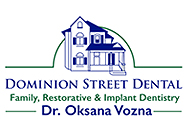Digital dental x-rays provide accurate diagnosis in Alliston, ON

Today it is almost unimaginable to find a dentist who does not use radiographs, or x-rays. Dental x-ray technology is relied upon for diagnosing problems not visible to the naked eye and monitoring oral development. Since its introduction into dentistry in the late 1800s, teeth x-ray science has seen tremendous advances. Dr. Oksana Vozna utilizes contemporary digital dental x-rays to help her patients in the Alliston, ON area enjoy healthy mouths.
How x-rays “see” inside the body
A problem that has occurred on the visible portion of a tooth can be examined with the naked eye. However, issues within the tooth or below the gum line present a much greater challenge. Before the advent of x-rays, a dentist had to cut through gum tissue to see what was happening with tooth roots or surrounding bone. Otherwise, diagnosis hinged only upon obvious symptoms.
In 1895, a German physicist named Wilhelm Röntgen accidently discovered the basis of x-rays while developing cathode-ray tubes. He determined that radiation generated by the tubes passed through some human tissues, but bones and teeth stopped it, creating shadows. He used these shadows to make pictures of the hard tissues.
In science, the letter “X” is typically used to describe a factor that is not defined. Since the kind of radiation Röntgen discovered had not yet been identified, it became known as x-rays. Though x-rays were initially used in industry, it didn’t take long for the medical profession to grasp the amazing potential. Within just a few months, doctors were using x-rays to plan surgeries, and dentists were not far behind. In 1896, the first dental x-ray of a living person was taken in the US.
Since the 1950s, x-rays have become a routine part of preventive dental services, helping to detect oral problems early, before they cause discomfort and destruction and while they are most treatable. Though precautions are taken to protect patients, traditional film x-rays emit low amounts of radiation. This is especially concerning with dental x-rays, since they are focused near the brain.
Digital dental x-rays resolve concerns with radiation, reducing the already low exposure by as much as 90 percent. There are many other benefits – to the patient, dental team, and even the environment – as well.
When a digital dental x-ray is essential
The process for having a digital x-ray taken is efficient and painless. An electronic digital sensor is inserted into the patient’s mouth to capture images. The pictures are available immediately, projected on a monitor for you and the dentist to view.
Dr. Vozna recommends periodic intraoral radiography (x-rays taken inside the mouth) on a scheduled basis, tailored to your oral condition – usually at least every other year. Bitewing x-rays, which are called that because you bite down on a wing-shaped device, are the most common view. Bitewings show upper and lower molars and bicuspids. They help the dentist spot decay hidden between back teeth, monitor overall dental health, and keep a watchful eye on how a child’s teeth are coming in.
Additional views may be needed to diagnose conditions such as:
- Decay in any other areas of the mouth
- Crown or root fractures
- Root abscess
- Abnormal growths
- Impacted teeth
- Hard tissue destruction from gum disease
How patients in Alliston, ON benefit from digital dental x-rays
Digital dental x-ray price is comparable to traditional film x-rays, and is cost-effective. For example, if tooth decay goes undetected for a while, the expense of a large filling or dental crown procedure necessary to restore it easily exceeds the cost of preventive x-rays.
Here are some additional advantages:
- Reduced chair time – There is no need to wait for film to be developed. The digital x-ray sensor produces images instantly.
- Comfort – The x-ray sensor is small and fits the mouth without pinching. Plus, you only need to bite on it for a few seconds, since the process is fast.
- Safe for children – Dramatically reduced risk of radiation exposure makes especially good sense for little patients whose bodies are still developing, as well as for health-savvy adults.
- Treatment planning and patient education – Dr. Vozna uses x-ray images to explain her diagnosis clearly and show you problem areas, helping you make informed care decisions. This is part of an overarching philosophy of transparency at Dominion Street Dental.
- High-resolution images – Digital technology produces well-defined pictures that are not limited to film size. Dr. Vozna can zoom in on the computer screen for a magnified view of tooth structure, and adjust contrast and brightness to show cavities or abnormalities more clearly. We are happy to provide a printed hard-copy of your x-rays at your request.
- Integrated care – With your consent, digital images can easily be emailed or saved to a flash drive. This feature makes it easy to share diagnosis with your other healthcare providers, or transfer them to your new dentist, should you move away from the Alliston area.
- Environmentally friendly – Harsh chemicals are needed to develop traditional film x-rays. Digital radiography does not require this. The process is safer for the dental team, and there are no waste chemicals to dispose of.
- Accurate diagnosis – Keeping your mouth healthy is, of course, the primary goal of dental care and the reason for taking x-rays. Computer software, such as subtraction radiography, is continually evolving to help dentists find even very small changes in tooth structure.
Dr. Vozna believes that the welfare of her patients is well worth the investment in equipment and staff training necessary to offer digital x-rays. Become a Dominion Street Dental patient to experience this high level of care. The number in Alliston, ON is (705) 435-4124.



